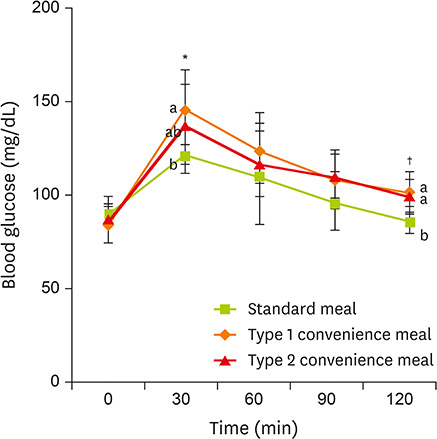Clin Nutr Res.
2017 Jul;6(3):215-220. 10.7762/cnr.2017.6.3.215.
Short-Term Effect of Convenience Meal Intake on Glycemic Response and Satiety among Healthy College Students in South Korea
- Affiliations
-
- 1Department of Food and Nutrition, Korea National University of Transportation, Jeungpyeong 27909, Korea. mhkim1129@ut.ac.kr
- KMID: 2385626
- DOI: http://doi.org/10.7762/cnr.2017.6.3.215
Abstract
- This study examined the effect of convenience meals purchased at convenience stores on glycemic response and satiety in healthy college students. A total of 9 non-obese volunteers (4 males and 5 females) aged 20 to 24 years participated in this study. On 3 separate days, participants consumed a standard diet (cooked rice and side dishes), type 1 convenience meal (kimbap and instant ramen), and type 2 convenience meal (sweet bread and flavored milk). Capillary blood-glucose response and satiety were measured every 30 minutes for 2 hours after consuming the 3 different test meals. Although mean fasting glucose levels were not different, glucose levels at 30 minutes and 120 minutes after the type 1 convenience meal intake were significantly higher than those in the standard meal (p < 0.05, p < 0.01). Total glucose response was higher after consumption of the type 1 convenience meal, followed by the type 2 convenience meal and standard meal (p < 0.05). Though the type 2 convenience meal contained higher calorie than the other meals, satiety of the type 2 convenience meal was lowest at 30 minutes and 60 minutes after consumption (p < 0.01, p < 0.05). This pilot study suggests that convenience meals may increase glycemic response or induce higher calorie intake with low satiety compared with nutritionally balanced Korean style meal.
Figure
Reference
-
1. Pae M. Dietary habits and perception toward food additives according to the frequency of consumption of convenience food at convenience stores among university students in Cheongju. Korean J Community Nutr. 2016; 21:140–151.
Article2. Lee KA, Cho EJ, Yoon HS. A study on consumption of convenience foods of university students by residing types in Changwon and Masan area. J Korean Diet Assoc. 2010; 16:279–290.3. Moon SJ, Yoon HJ, Kim JH, Lee YJ. A study on the perception and consumption pattern of convenience foods by Korean college students. Korean J Diet Cult. 1998; 13:227–239.4. Kim SJ, Bu SY, Choi MK. Preference and the frequency of processed food intake according to the type of residence of college students in Korea. Korean J Community Nutr. 2015; 20:188–196.
Article5. Einarson TR, Machado M, Henk Hemels ME. Blood glucose and subsequent cardiovascular disease: update of a meta-analysis. Curr Med Res Opin. 2011; 27:2155–2163.
Article6. Gerstein HC, Santaguida P, Raina P, Morrison KM, Balion C, Hunt D, Yazdi H, Booker L. Annual incidence and relative risk of diabetes in people with various categories of dysglycemia: a systematic overview and meta-analysis of prospective studies. Diabetes Res Clin Pract. 2007; 78:305–312.
Article7. McKeown NM, Meigs JB, Liu S, Saltzman E, Wilson PW, Jacques PF. Carbohydrate nutrition, insulin resistance, and the prevalence of the metabolic syndrome in the Framingham Offspring Cohort. Diabetes Care. 2004; 27:538–546.
Article8. Zhou XH, Qiao Q, Zethelius B, Pyörälä K, Söderberg S, Pajak A, Stehouwer CD, Heine RJ, Jousilahti P, Ruotolo G, Nilsson PM, Calori G, Tuomilehto J; DECODE Study Group. Diabetes, prediabetes and cancer mortality. Diabetologia. 2010; 53:1867–1876.
Article9. Jung EY, Suh HJ, Hong YH, Lee IY, Kim DG, Kim MO, Chang UJ. Effects of glycemic index for boiled white rice and boiled white rice mixed with grains on food consumption and satiety rate. J Korean Diet Assoc. 2009; 15:179–187.10. Josic J, Olsson AT, Wickeberg J, Lindstedt S, Hlebowicz J. Does green tea affect postprandial glucose, insulin and satiety in healthy subjects: a randomized controlled trial. Nutr J. 2010; 9:63.
Article11. Lim YS, Park HR, Han GJ. Comparison of preference for convenience and dietary attitude in college students by sex in Seoul and Kyunggi-do area. J Korean Diet Assoc. 2005; 11:11–20.12. Roberts SB. High-glycemic index foods, hunger, and obesity: is there a connection? Nutr Rev. 2000; 58:163–169.
Article13. Flint A, Gregersen NT, Gluud LL, Møller BK, Raben A, Tetens I, Verdich C, Astrup A. Associations between postprandial insulin and blood glucose responses, appetite sensations and energy intake in normal weight and overweight individuals: a meta-analysis of test meal studies. Br J Nutr. 2007; 98:17–25.
Article14. Rolls BJ. Carbohydrates, fats, and satiety. Am J Clin Nutr. 1995; 61:960S–967S.
Article15. Slavin J, Green H. Dietary fibre and satiety. Nutr Bull. 2007; 32:32–42.
Article
- Full Text Links
- Actions
-
Cited
- CITED
-
- Close
- Share
- Similar articles
-
- Thermic Effect of Food, Macronutrient Oxidation Rate and Satiety of Medium-chain Triglyceride
- Effect of Pre-meal Water Consumption on Energy Intake and Satiety in Non-obese Young Adults
- Thermic Effect of Food, Macronutrient Oxidation Rate and Satiety of High-fat Meals with Butter and Sesame Oil on Healthy Adults
- Chia seed (Salvia Hispanica L.) added yogurt reduces short-term food intake and increases satiety: randomised controlled trial
- Influence of the Size of the Spoon on the Eating rate, Energy Intake and the Satiety Levels of Female College Students



